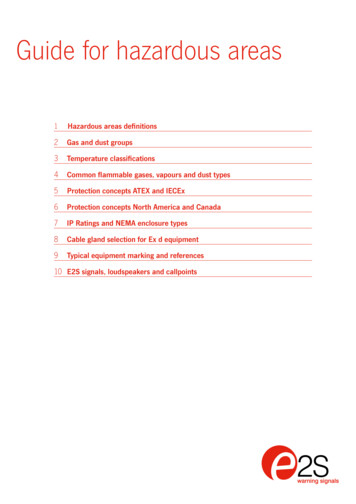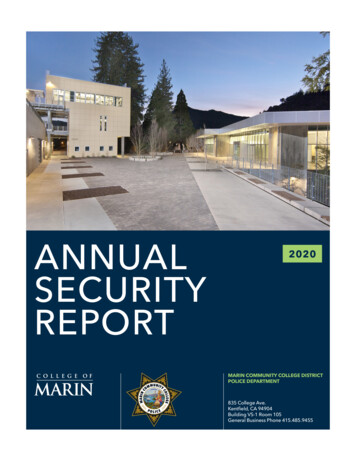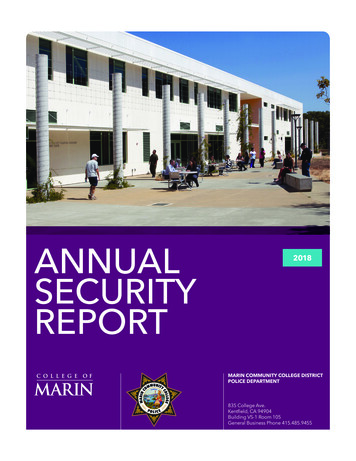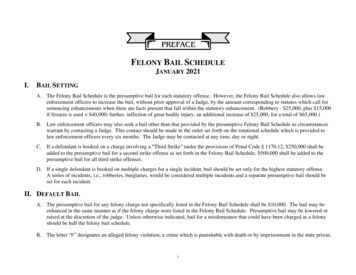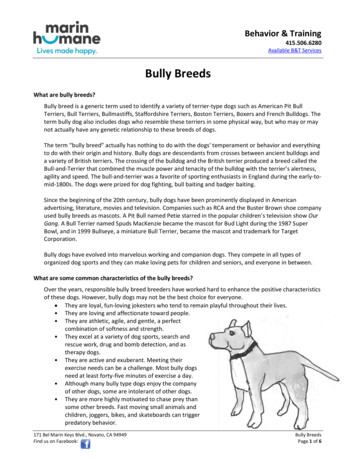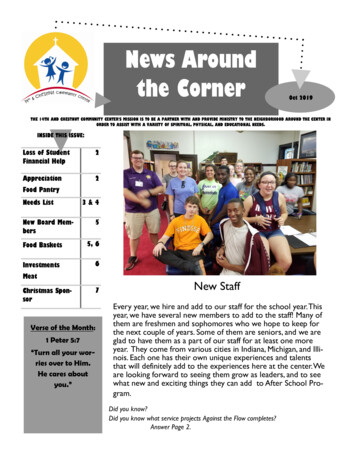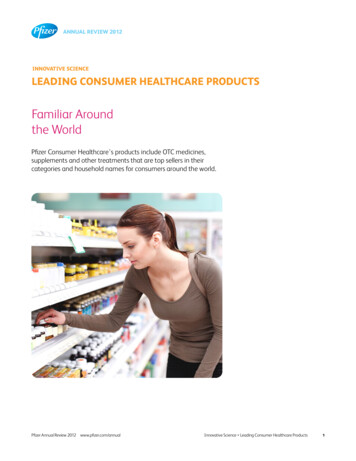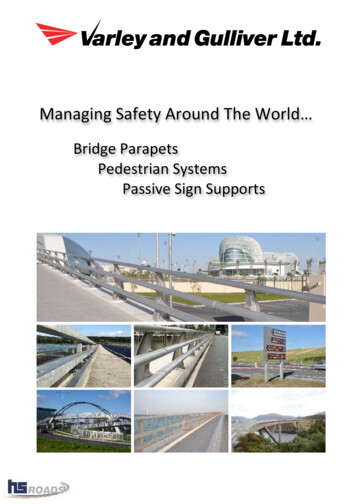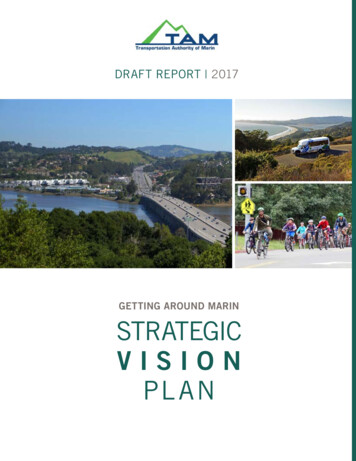
Transcription
DRAFT REPORT 2017GETTING AROUND MARINSTRATEGICVISIONPL AN
2
GETTING AROUND MARINABOUT TAM“The Transportation Authority of Marin (TAM), as a Congestion Management Agencyand the Transportation Sales Tax Authority of Marin County, manages transportationprojects in Marin County, California, with local, regional, state, and federal funding.According to TAM’s mission statement:TAM is dedicated to making the most of Marin Countytransportation dollars and creating an efficient and effective systemthat promotes mobility and accessibility by providing a variety ofhigh quality transportation options to all users.1TAM’s mandate is clear, and to advance our mission, TAM must balance a wide rangeof needs, challenges and opportunities across a variety of modes, partners, andnetworks to create an efficient and effective transportation system. To help guidetransportation improvements and remain competitive for project funding, TAM hasadopted principles, goals, and objectives that seek to move our mission statement intoimplementation in the local communities of Marin.1DRAFT REPORTTransportation Authority of Marin, http://www.tam.ca.gov/index.aspx?page 343.3
ContentsOVERVIEW. . . . . . . . . . . . . . . . . . . . . . . . . . . . . . . . . . . . . . . . . . . . . . . 6ACCOMPLISHMENTS SINCE 2003 VISION PLAN. 10RELEVANT STUDIES AND PLANS . 12TAM’S ADOPTED GOALS AND OBJECTIVES. 14ABOUT TRANSPORTATION FUNDING . 16GETTING AROUND MARIN TODAY. . . . . . . . . . . . . . . . . . . . . . . . . . . . 18DEMOGRAPHICS . 20TRANSPORTATION. 26ROAD NETWORK. 31TRANSIT. 33SCHOOL TRANSPORTATION . 38SENIOR MOBILITY. 40PUBLIC PARTICIPATION AND OUTREACH. . . . . . . . . . . . . . . . . . . . . . . 42PUBLIC OUTREACH 2015. 44TRANSPORTATION VISION ONLINE SURVEY . 46INNOVATION . 57TRANSPORTATION VISION. . . . . . . . . . . . . . . . . . . . . . . . . . . . . . . . . . 60PLANNING FRAMEWORK. 62VISION FOR THE FUTURE. 63HOW DO WE GET THERE? . . . . . . . . . . . . . . . . . . . . . . . . . . . . . . . . . . 68PATH FORWARD. 76INVESTMENTS TO SUPPORT THE VISION. 774
GETTING AROUND 1234567891011121314151617181920212223DRAFT REPORTTAM GOALS AND OBJECTIVES. . . . . . . . . . . . . . . . . . . . . . . . . . . . . . . . . . . . . . . . .MARIN COUNTY FUNDING SOURCES . . . . . . . . . . . . . . . . . . . . . . . . . . . . . . . . . . .MARIN COUNTY MUNCIPALITIES AND LOCAL JOB TOTALS . . . . . . . . . . . . . . . . . . .MARIN COUNTY POPULATION GROWTH, 1960-2015. . . . . . . . . . . . . . . . . . . . . . . .REGIONAL HOUSING NEED ALLOCATION, 2014-2022. . . . . . . . . . . . . . . . . . . . . . .BUILDING PERMITS ISSUED, 2007-2014. . . . . . . . . . . . . . . . . . . . . . . . . . . . . . . .MARIN COMMUTE MODE CHOICE. . . . . . . . . . . . . . . . . . . . . . . . . . . . . . . . . . . . . .DAILY PER CAPITA VEHICLE MILES TRAVELED (VMT). . . . . . . . . . . . . . . . . . . . . . . .AFTERNOON VEHICLE TRIPS (3-7PM). . . . . . . . . . . . . . . . . . . . . . . . . . . . . . . . . . .REGIONAL COMMUTE PATTERNS IN MARIN COUNTY. . . . . . . . . . . . . . . . . . . . . . .MARIN’S PRIMARY ROAD AND HIGHWAY NETWORK . . . . . . . . . . . . . . . . . . . . . . . .GOLDEN GATE TRANSIT BUS ROUTES WITH HIGHEST RIDERSHIP . . . . . . . . . . . . .MARIN TRANSIT BUS ROUTES WITH HIGHEST RIDERSHIP . . . . . . . . . . . . . . . . . . .MARIN TRANSIT ROUTES. . . . . . . . . . . . . . . . . . . . . . . . . . . . . . . . . . . . . . . . . . . .PRIORITIES. . . . . . . . . . . . . . . . . . . . . . . . . . . . . . . . . . . . . . . . . . . . . . . . . . . . . .MOST COMMON TRANSPORTATION VALUES BY PRIMARY TRAVEL MODE. . . . . . . . .SECONDARY MODE SPLIT, BY PLACE OF RESIDENCE . . . . . . . . . . . . . . . . . . . . . . .PERCENT OF RESPONDENTS WHO AGREE WITH THE FOLLOWING STATEMENTS. . .PRIMARY MODE SPLIT OF SURVEY RESPONDENTS, BY AGE GROUP . . . . . . . . . . . .PRIMARY MODE SPLIT OF SURVEY RESPONDENTS. . . . . . . . . . . . . . . . . . . . . . . . .SECONDARY MODE SPLIT OF SURVEY RESPONDENTS, BY AGE GROUP. . . . . . . . . .ESTIMATED TRANSPORTATION FUNDING SOURCES FOR MARIN COUNTY . . . . . . . .FUNDING AND REVENUE ALLOCATION OVERVIEW. . . . . . . . . . . . . . . . . . . . . . . . . .14172223242526272830323434364547495152525469745
01OverviewThe Strategic Vision Plan is a long-range planproviding a vision for all modes of transportationin Marin County. This vision consists of programsspecifically developed and tailored to Marin’sunique needs, history, and culture, resulting in astrategy to protect and enhance Marin’s quality oflife and natural beauty.As a Vision Plan, this report articulates a sharedconsensus around what our transportation systemwill look like in the future from the perspectivesof the public, who relies on the system, andof our local transportation providers, whoplan, maintain and operate our transportationinfrastructure.TAM’s vision is of an efficient and effectivetransportation system, one that enhances ourscenic environment, provides equity for all of ourusers (including our vulnerable populations), andgrows our economy for our residents, visitors, andworkforce.Marin’s leadership in considering all modes oftransportation serves as a building block towardachieving this vision and reflects the local plansand goals of our small towns and cities, transitoperators, and transportation providers, whileadvancing critical new technologies and bestpractices to address our growing transportationchallenges.6
GETTING AROUND MARINPedestrians enjoying Sausalito’s wide sidewalksDRAFT REPORT7
As an update to the 2003 Vision Plan, MovingForward: A 25-Year Transportation Vision forMarin County, the development of the StrategicVision Plan builds on the foundation establishedin the original transportation blueprint for MarinCounty. The Strategic Vision Plan reflects theadvancements in our transportation systemsince 2003, and the increased knowledge basefrom plans, studies, and reports of our localconditions and travel choices. Nearly 15 years ofinvestments and changes to our transportationsystem have passed since that plan wascompleted, and while many of today’s challengesand mobility needs are similar, the specifics haveevolved.This update provides an opportunity to revisitMarin’s transportation planning needs andredefines the Vision Plan from 2003 to matchtoday’s’ challenges and solutions, and isinformed by the following considerations andapproaches:8 A track record of completed projects andenhancements made to the transportationsystem since the 2003 Vision Plan adoption Substantial planning efforts and studies thathave advanced our understanding of the localand regional issues facing our transportationnetwork Ongoing and extensive public andstakeholder outreach and communitydiscussion that has occurred since 2003 onprojects, plans, and funding needs Opportunities for harnessing rapidlyexpanding technological advancements andinnovation to address our challengesThis document begins with a definition of Marin’stransportation challenges and opportunities;followed by an overview of the planning, outreach,and stakeholder engagement processes that havehelped shape the vision; and concludes with atransportation vision and supporting strategiesthat will address key transportation challenges,improve mobility, and enhance our quality of life.This report considers Marin’s planning frameworkand identifies funding sources, projects, andprograms that support implementation of theStrategic Vision Plan.The Strategic Vision Plan is designed to be afluid document that can adapt to changes in thetransportation setting. Therefore, this documentmay be updated, changed, or modified to respondto economic, demographic, technological, andother changes in our society, and does notestablish any implementation regulations orrequirements. This format provides a statusreport, a framework for future decision-makingregarding transportation investments andimprovements in Marin County that reflectscurrent needs and values, and an understandingof future challenges.
GETTING AROUND MARIN“FINAL REPORTThis report considersMarin’s planningframework and identifiesfunding sources, projects,and programs thatsupport implementationof the Strategic VisionPlan.9
ACCOMPLISHMENTS SINCE2003 VISION PLANIn 2003, TAM’s predecessor agency, theMarin County Congestion ManagementAgency, prepared Moving Forward: A 25-YearTransportation Vision for Marin County. This2003 Vision Plan provided direction for planningactivities and future revenue discussions,ultimately assisting in the development of TAM’shalf-cent Transportation Sales Tax ExpenditurePlan.The 2003 Vision Plan aimed to achieve thefollowing goals: Create a multimodal transportationsystem, emphasizing alternativesto single-occupant driving. Reduce overall congestion, not just onHighway 101 but also on roads providingconnections and alternatives to freeway travel. Maximize mobility for all residents ofMarin County including seniors, youth,and disadvantaged residents. Maintain the quality of lifeenjoyed in Marin County.LOCAL TRANSIT Expansion of local transit services,paratransit services, West Marin transitservices, and the Muir Woods Shuttle. Institution of Marin’s Senior MobilityServices through Marin Access tomeet the transportation needs of olderadults and people with disabilities. Major completion of the Sonoma-MarinArea Rail Transit (SMART) rail service toSan Rafael and agreement on full fundingfor the SMART Larkspur Extension.HIGHWAYS Completion of the Highway 101 Gap ClosureProject in San Rafael, the high-occupancyvehicle (HOV) lane, and separated (ClassI) multi-use path through Central Marin. Major progress in the Marin Sonoma Narrows,including extension of segments of the HOVlane, Phase 1 grade separations, redirectionof driveways to new frontage roads, andimplementation of new Class I and ClassII facilities for bicycles and pedestrians.2 Maintain flexibility to allow for differentneeds in different parts of the countyand to respond to changing conditions,including changes in funding.The 2003 Vision Plan’s goals and objectivesare still relevant today. This clear articulationof vision and goals was instrumental in settingthe stage for a transportation sales tax forlocal transportation investment. Passage ofthe 1/2–cent transportation sales tax (MeasureA) in 2004, and an annual 10 VehicleRegistration Fee (VRF), provided a reliablefunding stream for local streets and roadsmaintenance, major roadway improvements,Safe Routes to Schools programs, and localtransit services. The list below provides anoverview of completed and successful efforts,organized by mode of transportation.10Highway 101 Gap Closure Project and Class 1 Multi-Use Pathin San Rafael2Class 1 bike and pedestrian facilities provide fullseparation for vehicle traffic; Class 2 facilities are located onstreet and are striped as a separate lane (conventional bikelanes).
GETTING AROUND MARINCOMPLETE STREETSTRANSPORTATION DEMAND MANAGEMENT Ongoing success of the Safe Routes toSchools Education and Outreach program,with an average of over 50% GreenTrips 3 in over 55 schools countywide,reducing congestion on our roadways. Commute alternatives support programsincluding a vanpool incentive to support higheroccupancies in local vanpools, EmergencyRide Home to guarantee a ride home tocommuters who leave their car at home, andTAM’s innovative Lyft incentive program forfirst and last mile trips to SMART stations. Funding and implementation of nearly 20million in Safe Pathways capital projectsto increase safe access to schools, andplacement of 82 crossing guards near schools. Major road improvements including 4thStreet in San Rafael, Miller Avenue in MillValley, Sir Francis Drake Boulevard thruSamuel P. Taylor Park in West Marin, andportions of Novato Boulevard in Novato. Bike and pedestrian investments throughRegional Measure 2 fund sources including theCentral Marin Ferry Connector, Cal Park hilltunnel, Lincoln Hill Pathway, and progress onthe North South Greenway throughout Marin.OTHER EFFORTS Passage of the Local Transportation SalesTax, allowing for leveraging funds for localhighway and other improvements fromregional state and federal sources. Passage of the Marin 10 VehicleRegistration Fee to support ongoing roadand pathway maintenance needs, seniormobility needs, commute alternatives,and low-emission vehicle programs. Significant planning and investmentsfrom Marin County’s Non-MotorizedTransportation Pilot Program and regionalMeasure 2 Bridge Toll Program.“While not an exhaustivelist of accomplishments,significant progress has beenmade in physical changes tothe transportation network,enhanced by the availability oflocal funding sources to attractand leverage regional, stateand federal funding.A bicyclist on Bridgeway in Sausalito3Marin County Safe Routes to Schools ProgramEvaluation Report, 2016.DRAFT REPORT11
Relevant Studies and PlansWhile many of the projects and programsTRANSIT AND TRANSIT CORRIDOR PLANSenvisioned in the 2003 Vision Plan have beenTo assess transit performance and identify howbest to improve the transit system, TAM workswith Marin Transit and Golden Gate Transitto move commuters, seniors, students, andother transit users that reduce demand on ourlocal roadways. These plans range from needsassessments for local communities, and marketanalysis for the county as a whole to understandwhat local transit needs are, to service planslike the short range Transit Plan that identifiesservices to be implemented over the next threeyears, and specific evaluation reports to monitorand improve services like the Muir Woods shuttle.implemented, there are a number of otherplans, listed below, that inform local knowledgeof travel behavior and serve as the basisfor delivering transportation services to theCounty. These plans do not “sit on a shelf” butrather provide an understanding of the causeof our existing challenges, develop potentialsolutions, and identify the financial resourcesto implement these issues. Each plan andstudy furthers our understanding of Marin’stransportation system and supports futureprogramming and funding decisions.Each of these plans serve critical functions; insome cases plans are developed to improvemobility, some to enhance local communities, Bettini Transit Center Relocation Study Short Range Transit Plans for MarinTransit and Golden Gate Bridge,Highway and Transportation District(rural Fixed-Route Expansion Plan)and others to prioritize investments. Using Muir Woods Shuttle Evaluation Reportsthis base of knowledge, TAM advances critical The Central/Southern Marin Transit Studyprojects and programs with a multitude oflocal, state and federal funding sources tomaximize local competitiveness for funding.These plans also serve to define whatimprovements could be considered in the nearterm, and serve to address current needs whilepreparing for a future transportation system.These plans include the following: Fairfax San Rafael Transit Corridor Study Countywide Transit Market Assessment Marin Access Strategic Analysisand Recommendations Marin Senior Mobility Actionand Implementation Plan Coordinated School Transportation Study Community Needs Assessments(Tiburon and Novato) Metropolitan Transportation Commission’s(MTC) SMART Integration Plan12
GETTING AROUND MARINROADWAY PLANSBIKE AND PEDESTRIAN PLANSRoadways in Marin County are prioritized withlocal jurisdiction staff for improvements, withlocal dedicated transportation funding supportfrom TAM. Local transportation funds are criticalfor the planning, design, public engagement andconstruction of these projects, and can leverageregional, state and other funds to make ourroadways safe and accessible for all users. Congestion Management PlanMarin County has a history of bike andpedestrian planning, with many walkable andbikeable neighborhoods and communities. TAMcoordinates many of these plans with our localcities and towns to promote projects for fundingthrough regional and state Active Transportationfunding and local Safe Pathways funding.Additionally, TAM supports the development ofmany multimodal projects incorporating bike andpedestrian planning efforts through completestreets development. Miller Avenue Streetscape Project Safe Routes to Schools Evaluation Report Sir Francis Drake Boulevard RehabilitationProject (Highway 101 to Ross) Local Jurisdiction Bicycle/Pedestrian Plans General Plans, Capital Improvement Plans Bikeshare Feasibility Study Sir Francis Drake BoulevardRehabilitation Project (West Marin) Non-motorized Transportation Pilot Program Novato Boulevard Improvement Project Multimodal roadway, highway, andtransit plans identified aboveCOMMUTE ALTERNATIVES AND CLEANCOMMUNITY BASED TRANSPORTATIONTECHNOLOGY PLANSPLANSMarin County boasts the second-highest electricvehicle adoption rate per capita in California,and TAM has developed programs and plansthat support Marin’s goals of environmentalstewardship. TAM supports public agencyadoption of clean air technology, including publicfunding of charging stations, and clean fuel fleetvehicles with local dedicated transportationfunds.These plans advance equity-based developmentof our transportation system, prioritizing projectsand programs for funding through Lifeline andother Funding Programs. Siting and placement plans for electricvehicle charging stations in Marin County. The City of Novato Community BasedTransportation Plan, 2015 The Canal Neighborhood CommunityBased Transportation Plan, 2007 The Marin City Community BasedTransportation Plan, 2009, 2015 Employer/employee support programsincluding Guaranteed Ride Home, teleworkinitiatives, innovative carpool pilot programs,and regional rideshare coordination. SMART MTC Integration Planand First/Last Mile Plans.FINAL REPORT13
TAM’S ADOPTED GOALS ANDOBJECTIVESTAM’s mission statement is provided below:“TAM is dedicated to making themost of Marin County transportationdollars and creating an efficientand effective system that promotesmobility and accessibility byproviding a variety of high qualitytransportation options to all users.”4TAM’s mission statement highlights two of itskey objectives: providing cost-efficient mobilityand accessibility and providing a variety of highquality transportation options. Mobility refersto the transportation system’s capacity to movepeople and goods from place to place, whileaccessibility refers to the ease of access for allusers. This is m
The Transportation Authority of Marin (TAM), as a Congestion Management Agency and the Transportation Sales Tax Authority of Marin County, manages transportation projects in Marin County, California, with local, regional, state, and federal funding. “According to TAM’s mission state

